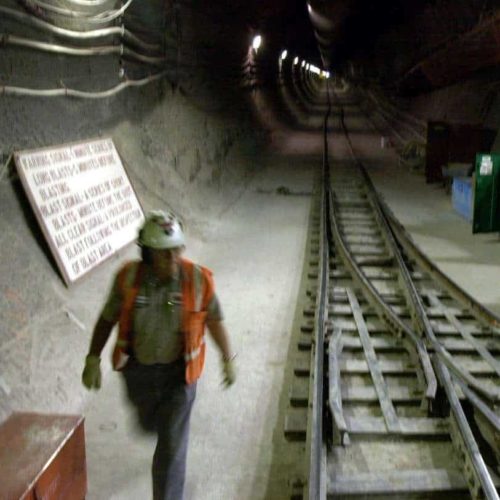Introduction
The Department of Energy is responsible for managing almost 13,000 metric tons of nuclear waste at sites in Colorado, Idaho, New York, South Carolina and Washington. For the past three decades, DOE planned to permanently dispose nuclear waste at Yucca Mountain, a geological repository in southwest Nevada. The cancellation of the project by the Obama administration in 2009 has left the department scrambling to come up with alternatives.
Since 1983, DOE has spent $14 billion to research potential sites, develop technical documents and apply to the Nuclear Regulatory Commission for a license for the Yucca Mountain repository, which was slated to open in 2020. When the administration decided to terminate the Yucca Mountain program and proposed cutting its funding, DOE tried to withdraw its license application from NRC. The commission declined to do so. As a result, the status of the Yucca Mountain program is still in limbo, but the DOE and Navy do not have backup plans in place for a different location the nuclear waster could be stored.
“The decision to forgo Yucca Mountain leaves DOE without a pathway to permanently dispose of spent nuclear fuel and high-level waste. In the absence of a repository at Yucca Mountain, some affected states and communities are concerned that DOE may store waste at its sites indefinitely,” the Government Accountability Office said in its report on the Yucca Mountain shutdown.
The Navy also stores spent nuclear fuel from submarines and aircraft carriers at the Idaho site. The agreements with Colorado and Idaho both specify a date when the DOE and Navy must remove the nuclear waste from these locations. The federal government may be liable to pay Idaho $60,000 and Colorado $15,000 for each day past January 1, 2035, that DOE and the Navy have not removed nuclear waste. Over a year, these fees total $27.4 million.
Aside from monetary consequences, the Navy’s agreement with the Idaho site could create national security concerns. The Navy removes nuclear fuel from warships and transports it to the Idaho site for storage. If Idaho halts Navy’s shipments of spent nuclear fuel, then warships cannot be refueled. According to the Navy, there are no other sites available for this type of storage and developing infrastructure at a different site would be costly and time consuming.
The year 2035 might sound like enough time to develop an alternative site, but preparations for Yucca Mountain began in 1983. An expert in nuclear storage estimated that opening a facility could take between 17 and 33 years from the time the site is selected until the facility can accept nuclear waste. For the Yucca Mountain repository, this process was predicted to take at least 37 years until the site could begin storing nuclear material, 2020 at the very earliest.
Now it’s very unlikely a replacement site will be ready by 2020, the original date DOE and the Navy planned to begin moving nuclear waste from the current sites to the Yucca repository.
Three of the sites would have to build additional storage if the nuclear waste stays at the site past 2020. The DOE estimated that the Hanford, Wash., site would need three additional storage facilities to accommodate all of the waste, which cost $100 million each. DOE estimates it could need an additional $918 million to extend storage if the opening of a permanent repository was delayed from 2020 to 2040.
DOE established a commission in 2010 to research alternatives for storing and managing the nuclear waste supply that was supposed to be stored in Yucca Mountain, but will not release its official recommendations until 2012.
“Without taking some preliminary steps to assess the information necessary to plan for long-term storage, DOE and the Navy will not have the understanding needed to proceed with such planning when the future direction becomes clearer,” GAO said.
FAST FACT: An alternative option includes keeping the nuclear waste at sites beyond the design lives of the current storage facilities. DOE officials acknowledged they did not know how long the facility would last because long-term storage at these sites has never been done. It is also unknown how long nuclear fuel can be stored before it starts to degrade, which makes transport to a different location later on very risky.
Read more in Environment
Environment
Nuclear fire protection: A critic’s view
Environment
Year after tragedy, mining industry seeks some self-policing
Coal companies urge government to reward safety with fewer inspections


Join the conversation
Show Comments